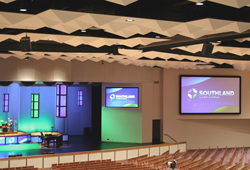
The biggest challenge was getting the boxes up and down, which we accomplished with a chain motor, and then a block and tackle was the key to pulling them into the catwalk.”
Coverage to the rear-most portions of the room is still provided by several Tannoy V12 compact loudspeakers flown in an arc from the ceiling, virtually invisible amidst the acoustical treatments.
These are time delayed in relation to the main loudspeakers, and are still offering solid, even coverage after several years on the job.
In fact, no other components needed to be added. The system’s original BSS Soundweb 90 Series digital signal processing network is in place, joined by the original QSC CX Series and PL Series power amplifiers.
These components are mounted in two racks housed in a secured, climate controlled room on an upper level behind the loudspeakers.
“One of the things that is so slick about this project is that the efficiency of the new loudspeakers, which makes them capable of such greater output levels, did not require any more power amplification than what was already on hand,” Roggow observes.
“It’s a cool thing to be able to get extended life from these components, a real bonus for the church.”
James Rutledge, lead sound operator at the church, adds, “Did you say headroom? We didn’t even change amps! It’s almost ridiculous how efficient the VQ boxes are – it sounds like they’re hardly working.
I’d say we ran the previous loudspeakers at about 85 to 95 percent most of the time, whereas with VQ, we’re running more in the 60 to 70 percent. That’s going to translate to longer life for amps as well as the speaker drivers.”
An Allen & Heath ML5000 mixing console, with sidecar extension, still anchors the house mix and system control position that’s centrally located on the sanctuary floor, joined by a wide range of effects and processing units that are rack-mounted in aesthetically matching cabinets.
Another ML5000 console is posted at one side of the platform, serving a mix of Shure in-ear personal monitor systems and well as stage wedges.
“There’s plenty of life left in these consoles, so any changes with them, or the rest of the system for that matter, can be addressed later, on an as-needed or wanted basis,” Garrison states, which points to another factor contributing to the success of this project: the benefit of an ongoing relationship between the client and systems firm.
“We naturally form close relationships with our clients, being very people oriented. With the personalities that make up our company, this comes naturally,” he concludes. “In this case, by staying in touch with each other and communicating about the system on a regular basis, we were all able to work together to arrive at a rather simple yet significant upgrade that truly benefits the church.”

